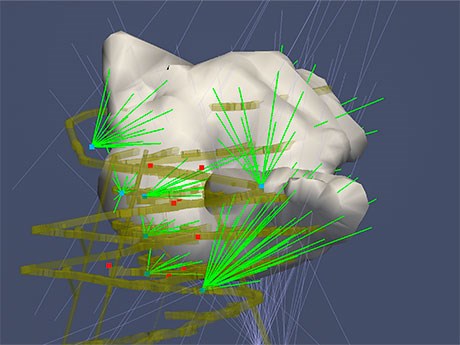Solution is applicable to late stage exploration or mining companies moving ground from resources to reserves
Sudbury startup Objectivity’s new Drilling, Reporting and Targeting solution could change the way geologists plan infill drill holes. Marketed as DRX, the data analysis solution uses optimization algorithms to calculate multiple drill hole layouts based on geologist-defined constraints and targets.
In infill drilling or resource calculation, there is a very clear measure of a positive end result: how much volume a set of drill holes is able to move into the indicated or measured categories,” said Andrew Dasys, founder and president of Objectivity.
“DRX in almost all cases can move that volume of ground with fewer drill holes.”
The solution is applicable to late stage exploration or a mining company that wants to take a volume of ground and move it from resources to reserves.
“DRX produces a drill plan that is compliant with all your requirements, but more importantly, it gives you a tool that can help you define what your budget should be and it does it very objectively, thus the name of the company,” said Dasys.
“Because it’s a mathematical assessment, it eliminates a lot of the subjectivity that can occur in planning drill holes because if you ask two geologists to lay out a set of drill holes, you may come up with two very different answers.
“DRX removes the human bias in the placement of holes…we take the historical drill hole data, we take the current interpretation of the volume of ground that is to be drilled and we suggest where a company can get the most value from placing holes at a high level of detail. That includes the modeling of the loft and curl, which is the predicted deviation of the holes as they’re drilled.”
Objectivity has several case studies to prove the effectiveness of DRX.
One study, verified by SRK Consulting demonstrated that Royal Nickel Corporation, owner of the Dumont nickel project in northwestern Quebec, was able to convert 15 per cent more ground into the measured category or get the same amount of tonnes with one-third less drilling, said Dasys.
“We had another case where we increased the conversion by over 80 per cent using the same number of metres.”
DRX was also used to target transition zones between high-grade gold and low-grade zones at an Iamgold property.
“They were trying to understand the geology around these transition zones and used DRX to help them place more holes in the transition zones while still doing a measured type of spacing,” said Dasys. “It’s a very difficult thing to do manually, in part because it’s three dimensional and the human brain is not well adapted to multi-variable optimization.
“If I give you a number of boxes with different volumes and ask you to pack the most boxes in a backpack, you’ll do a pretty good job. A computer will almost always beat you, but if those boxes have different shapes and different densities and I ask you to maximize the mass in the backpack, a computer will always beat you.
“We’re not as a species particularly good at complex, detailed decisions and that’s where algorithms shine.”
DRX doesn’t pose a threat to geologists, insists Dasys. On the contrary, it makes them more effective.
“We’re saying the individual has more value doing interpretation and making higher-level decisions with a new set of data that wasn’t available before.
“If you go back 25 years and have an open pit, there was an individual who decided the shape of the pit. A company called Whittle came up with a solution to figure out the shape of a pit. Today, everybody uses automated pit optimization. We believe DRX is that kind of tool that moves the manual process of drawing holes to something that can take all of your existing data and come up with a drill hole plan for a given budget.”
At the PDAC in March, Objectivity teamed up with another company called Vektore, a structural economic geology consultancy led by Rogerio Monteiro, who joined Inco as senior exploration geologist in 1997 and Vale Global Exploration as chief structural geologist in 2007.
Vektore’s technology analyzes drill core, “identifies an angle to the mineralization” and “projects where the mineralization is heading,” explained Dasys. “This is new information we can bring into the DRX model.”
Both companies add value to resource calculation, can work together and refer business to each other, according to Dasys.



.jpg;w=120;h=80;mode=crop)